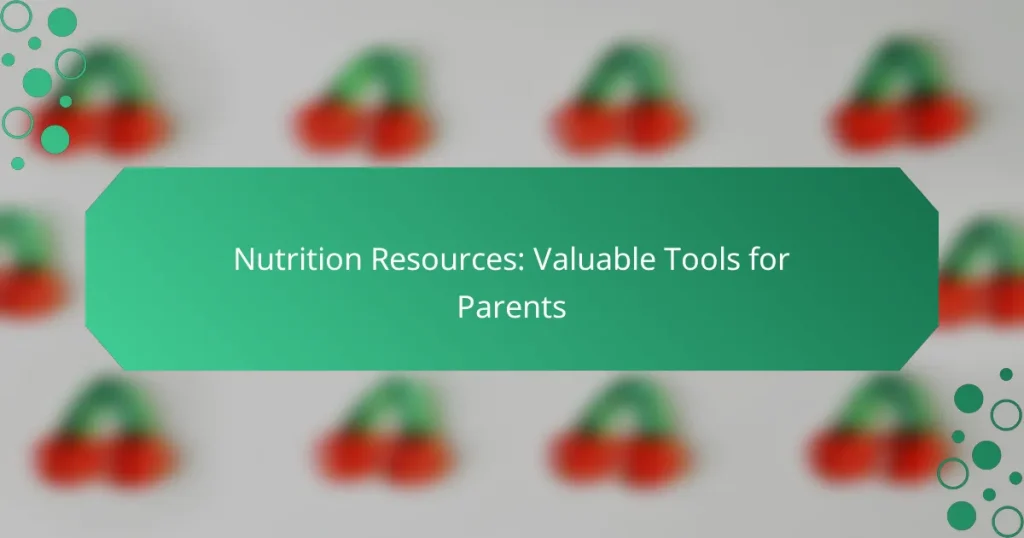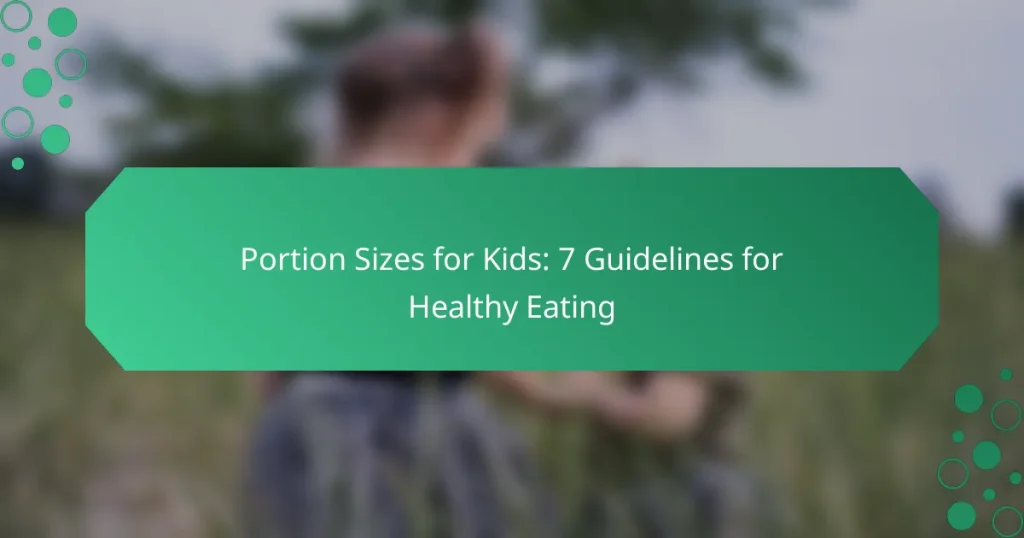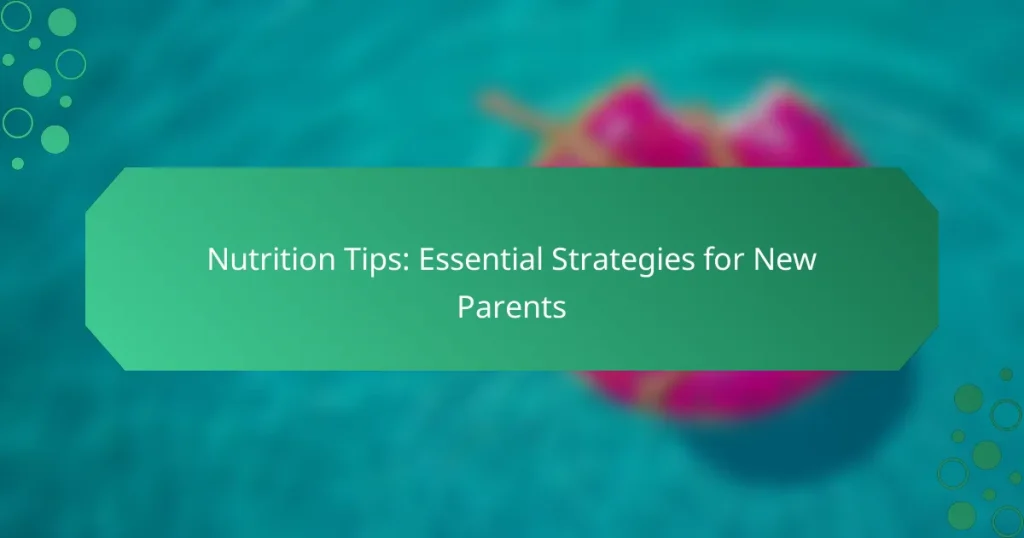Nutrition and wellness are vital for children's growth and development, making it essential for parents to understand their unique dietary needs. By focusing on balanced meals rich in fruits, vegetables, and healthy snacks, parents can promote better health and instill lifelong healthy eating habits. Engaging children in fun and interactive nutrition education can further enhance their interest in making nutritious food choices.
How Can Parents Improve Kids' Nutrition?
Parents can enhance their children's nutrition by focusing on balanced meals, incorporating a variety of fruits and vegetables, and providing healthy snacks. These strategies not only promote better health but also instill lifelong healthy eating habits.
Balanced meal planning
Balanced meal planning involves creating meals that include a mix of carbohydrates, proteins, and fats. Aim for meals that consist of whole grains, lean proteins, and healthy fats to provide essential nutrients. Consider planning meals for the week ahead to ensure variety and balance.
Use a simple formula: fill half the plate with fruits and vegetables, a quarter with lean protein, and a quarter with whole grains. This visual guide helps children understand portion sizes and the importance of a balanced diet.
Incorporating fruits and vegetables
Fruits and vegetables are crucial for children's growth and development. Aim to include a rainbow of colors in their diet, as different colors often represent different nutrients. Fresh, frozen, or canned options can all be nutritious choices, but be cautious of added sugars or sodium in canned varieties.
Encourage kids to try new fruits and vegetables by involving them in the selection and preparation process. Simple activities like visiting a farmers' market or planting a small garden can spark their interest in healthy foods.
Healthy snack options
Healthy snacks can help maintain energy levels and prevent overeating at meal times. Opt for snacks that combine protein and fiber, such as yogurt with fruit, whole-grain crackers with cheese, or hummus with veggies. These options are not only nutritious but also satisfying.
Keep a variety of healthy snacks readily available at home. This makes it easier for kids to make better choices when they feel hungry between meals.
Hydration strategies
Proper hydration is essential for children's overall health. Encourage kids to drink water throughout the day, especially during physical activities. Limit sugary drinks like sodas and fruit juices, as they can contribute to excessive calorie intake.
Consider using fun water bottles or adding slices of fruits to water to make it more appealing. Setting regular hydration breaks during activities can also help reinforce the habit of drinking enough fluids.
Portion control techniques
Teaching kids about portion control helps them understand their hunger cues and prevents overeating. Use smaller plates and bowls to create the illusion of a fuller plate, which can encourage appropriate portion sizes.
Encourage children to listen to their bodies by eating slowly and stopping when they feel satisfied, not full. This practice helps develop a healthy relationship with food and promotes mindful eating habits.
What Are the Key Nutritional Needs for Children?
Children have unique nutritional needs that are essential for their growth, development, and overall health. A balanced diet that includes a variety of foods helps ensure they receive the necessary nutrients for optimal physical and cognitive development.
Essential vitamins and minerals
Vitamins and minerals play crucial roles in children's health. Key nutrients include vitamin A for vision, vitamin D for bone health, calcium for strong teeth and bones, and iron for cognitive function. A diverse diet rich in fruits, vegetables, whole grains, and dairy can help meet these needs.
Parents should aim to include foods like leafy greens, dairy products, nuts, and lean meats in their children's meals. Regularly incorporating these foods can help prevent deficiencies and support healthy growth.
Macronutrient requirements
Children require a balanced intake of macronutrients: carbohydrates, proteins, and fats. Carbohydrates should make up about 45-65% of their daily caloric intake, providing energy for their active lifestyles. Proteins are essential for growth and should account for approximately 10-30% of their calories.
Healthy fats, which are important for brain development, should comprise about 25-35% of their diet. Sources of healthy fats include avocados, nuts, and olive oil. Parents should focus on whole, unprocessed foods to meet these macronutrient needs effectively.
Age-specific dietary guidelines
Dietary needs vary significantly by age. For toddlers (1-3 years), focus on whole grains, fruits, vegetables, and healthy fats, with an emphasis on small, frequent meals. Preschoolers (4-5 years) should have a balanced diet that includes protein sources and a variety of colors on their plates.
School-aged children (6-12 years) require increased calories and nutrients to support their growth spurts. Teenagers (13-18 years) have higher protein and calcium needs due to rapid growth and development. Parents should consult resources like the Dietary Guidelines for Americans to tailor their children's diets according to age and activity level.
How to Educate Kids About Healthy Eating?
Educating kids about healthy eating involves engaging them in fun and interactive ways that promote understanding and interest in nutritious foods. By incorporating hands-on activities, games, and real-life experiences, parents can instill lifelong healthy eating habits.
Interactive cooking activities
Interactive cooking activities are a great way to teach kids about healthy eating while allowing them to explore different ingredients. Involve your children in meal preparation by letting them wash vegetables, mix ingredients, or even choose recipes. This hands-on approach not only makes cooking fun but also helps them learn about nutrition and the importance of fresh foods.
Consider organizing themed cooking nights, such as "Taco Tuesday" or "Fruit Friday," where kids can experiment with various healthy toppings and ingredients. This encourages creativity and makes healthy eating more appealing.
Educational games and apps
Using educational games and apps can make learning about nutrition enjoyable for kids. Many apps are designed to teach children about food groups, portion sizes, and the benefits of healthy eating through interactive quizzes and challenges. Look for apps that are age-appropriate and encourage participation.
Games that involve food preparation or nutrition trivia can also be effective. For instance, a game that rewards kids for making healthy choices or completing cooking challenges can reinforce positive habits while keeping them engaged.
Involving kids in grocery shopping
Involving kids in grocery shopping is an excellent way to educate them about healthy eating choices. Take your children along to the supermarket and encourage them to help select fruits, vegetables, and whole grains. This not only teaches them about nutrition but also helps them understand where their food comes from.
While shopping, discuss the benefits of different foods and read labels together. Teach them to look for items with lower sugar and higher fiber content. This practical experience can empower them to make healthier choices independently in the future.
What Role Does Physical Activity Play in Wellness?
Physical activity is essential for children's overall wellness as it supports physical health, mental well-being, and social skills. Regular exercise helps develop strong muscles and bones, improves cardiovascular fitness, and promotes a healthy weight.
Recommended exercise guidelines
The American Heart Association recommends that children aged 6 to 17 engage in at least 60 minutes of moderate to vigorous physical activity each day. This can include activities like running, swimming, cycling, or playing sports. It's important to incorporate a mix of aerobic activities, muscle-strengthening exercises, and bone-strengthening activities throughout the week.
Parents should encourage their kids to participate in a variety of activities to keep them engaged and interested. Activities can be structured, like team sports, or unstructured, like playing at the park or riding a bike.
Benefits of active play
Active play offers numerous benefits, including improved physical health, enhanced mood, and better social interactions. Engaging in physical activity can reduce stress and anxiety, helping children develop resilience and emotional regulation.
Moreover, active play fosters creativity and problem-solving skills as children navigate games and sports. It also provides opportunities for teamwork and cooperation, essential skills for social development.
How Can Parents Address Picky Eating?
Parents can address picky eating by introducing a variety of foods in a positive and non-pressuring environment. This approach encourages children to explore different tastes and textures, making mealtime a more enjoyable experience.
Strategies to encourage diverse diets
To promote a diverse diet, parents can involve children in meal planning and preparation. This engagement can spark interest in new foods and make them more willing to try different options. Offering a colorful plate with a range of fruits, vegetables, and proteins can also make meals visually appealing.
Another effective strategy is to introduce new foods alongside familiar favorites. For instance, pairing a new vegetable with a child's preferred dip can make the unfamiliar item less intimidating. Repeated exposure, without pressure, can gradually increase acceptance of diverse foods.
Understanding food aversions
Food aversions in children can stem from various factors, including texture, taste, or previous negative experiences. Recognizing these aversions is crucial for parents to tailor their approach to feeding. For example, if a child dislikes the texture of cooked spinach, offering it raw in a salad may be more acceptable.
Parents should also be aware that food preferences can change over time. What a child refuses today might be embraced later. Keeping the atmosphere relaxed and maintaining a variety of options can help children feel more comfortable exploring their tastes.
What Are Common Nutritional Myths for Kids?
Common nutritional myths for kids often lead to misconceptions about healthy eating. Understanding these myths can help parents make informed choices about their children's diets.
Debunking sugar myths
One prevalent myth is that all sugar is harmful to children. While excessive sugar intake can lead to health issues, natural sugars found in fruits and dairy can be part of a balanced diet. Moderation is key, and it's essential to differentiate between added sugars and those naturally occurring in whole foods.
Parents should be cautious about the sources of sugar in their children's diets. For instance, sugary drinks and processed snacks often contain high levels of added sugars, which should be limited. Instead, encourage healthier options like whole fruits or yogurt, which provide essential nutrients along with natural sweetness.
To manage sugar intake effectively, consider reading nutrition labels and aiming for a daily added sugar limit of less than 10% of total calories. For a child consuming around 1,800 calories, this translates to about 45 grams of added sugar. Educating children about making healthier choices can foster lifelong habits that promote wellness.






